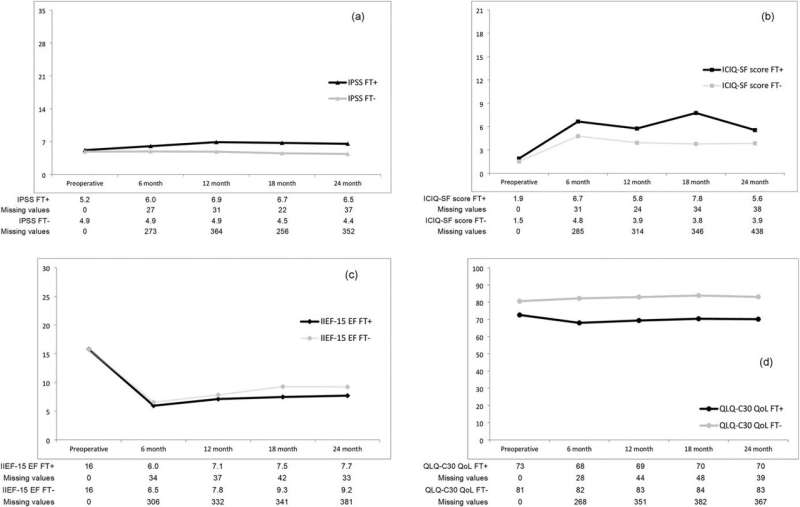Financial toxicity after robotic prostate cancer surgery: Younger patients at higher risk

Among men undergoing robot-assisted radical prostatectomy (RARP) for treatment of prostate cancer, younger patients are more likely to experience cancer-related financial toxicity, suggests a study in the Journal of Urology, an official journal of the American Urological Association (AUA). The journal is published in the Lippincott portfolio by Wolters Kluwer.
At least in the Netherlands, the overall rate of financial toxicity (FT) after RARP is relatively low. However, risk appears higher for men who are younger than retirement age and for those who experience increased urinary symptoms after RARP, according to the report by Oktay Özman, MD, and colleagues of the Netherlands Cancer Institute, Amsterdam.
New data on financial toxicity after modern prostate cancer surgery
Financial toxicity—referring to financial distress or hardship resulting from cancer and its treatment—is a relatively new concept in cancer care. Robot-assisted radical prostatectomy has emerged as the new standard of care for prostate cancer surgery, but has higher costs than previous surgical techniques. The new study evaluated the frequency of FT among patients undergoing RARP, including patient characteristics associated with greater financial impact.
Dr. Özman and colleagues evaluated responses to standard clinical questionnaires, including a measure of FT, by 1,479 patients who underwent RARP between 2006 and 2021. All patients included in the study reported no cancer-related financial difficulties before RARP. The analysis included questionnaire responses completed before RARP and at 6 to 24 months of follow-up.
Overall, 8.3% of patients experienced FT sometime within the 2-year follow-up period after RARP. Patients reporting FT were significantly younger than those without FT. Financial toxicity did not appear to be affected by the outcomes of cancer surgery, including the presence of positive surgical margins or the need for "salvage" radiation therapy.
Patient symptoms affecting frequency of financial toxicity
Financial toxicity was also more frequent among patients who had increased urinary and prostate-related symptoms after RARP. Scores for urinary incontinence—a major side effect of prostate cancer surgery—increased for 62% of patients reporting FT, compared to 47% without FT. Symptoms of erectile dysfunction, another frequent side effect, were unrelated to FT risk.
On adjusted analysis, factors independently related to the risk of FT were younger patient age, increased urinary symptom scores, and decreased quality of life scores. Financial toxicity was 60% more likely to occur in patients who underwent RARP before retirement age (65 years).
The relatively low rate of financial toxicity likely reflected the fact that patients incurred no out-of-pocket costs for robotic surgery under the national health insurance program in the Netherlands. Therefore, the researchers write, "[O]ur data reflect the pure impact of the surgical intervention on postoperative well-being." Studies from other countries have reported varying rates of FT, attributed to policy differences regarding coverage of direct costs.
The higher risk of FT among younger patients may reflect cancer-related reductions in income—for example, from reduced work hours or job loss—that are not incurred by older patients with a stable retirement income. The study is the first to report on the association between urinary or prostate symptoms and FT. Financial toxicity may be either "a cause or a consequence" of low quality of life, the researchers point out.
The study lends new insights into FT related to prostate cancer, specifically in the era of robotic surgery. "Patients who report urological symptoms after RARP should also be evaluated for FT," Dr. Özman and coauthors conclude. "Required measures against FT should be taken especially in the follow-up of younger cancer survivors."
More information: Oktay Özman et al, Financial Toxicity After Robot-Assisted Radical Prostatectomy and Its Relation with Oncologic, Functional Outcomes, Journal of Urology (2022). DOI: 10.1097/JU.0000000000002897





















